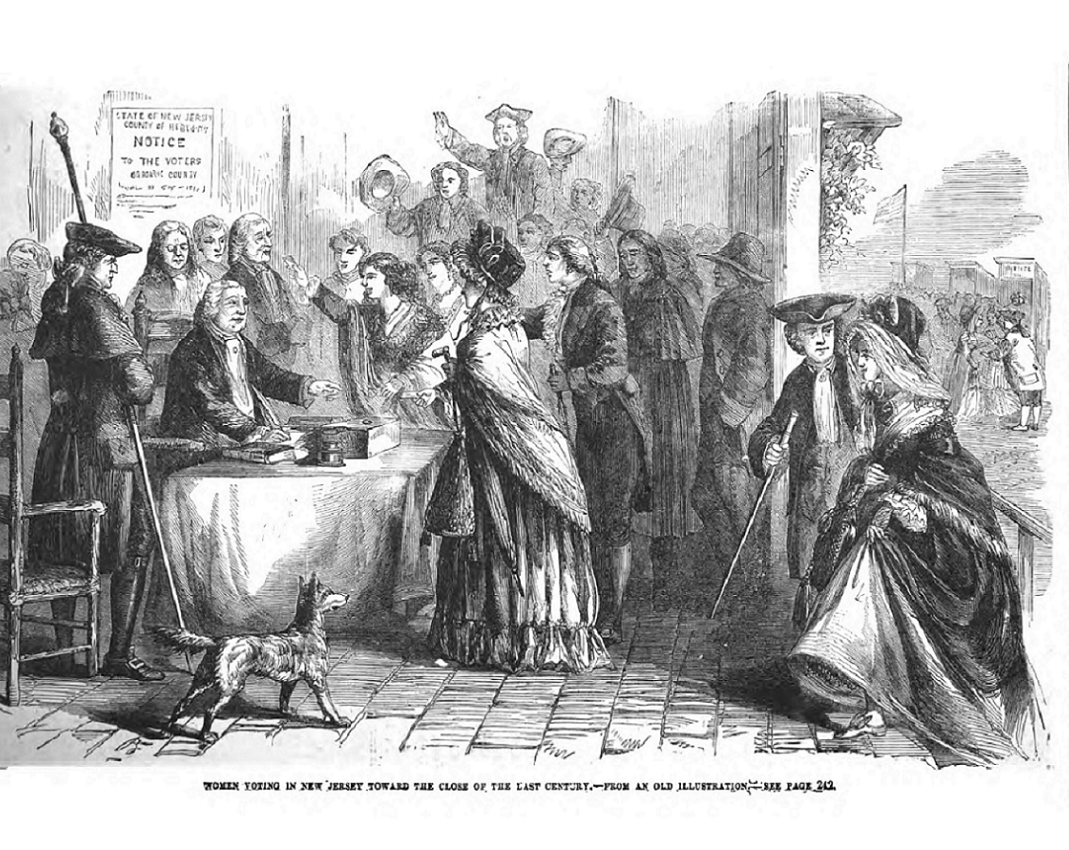Document Text |
Summary |
| All inhabitants of this colony of full age, who are worth fifty pounds proclamation money clear estate in the same, and have resided within the country in which they claim to vote twelve months immediately preceding the election, shall be entitled to vote. | You can vote in an election if you are old enough, have enough money, and have lived in the colony for at least a year. |
New Jersey State Constitution, 1776. New Jersey Department of State.
Document Text |
Summary |
| Every voter shall openly, and in full view deliver his or her ballot (which shall be a single written ticket, containing the names of the person or persons for whom he or she votes) to the said judge. . . | Every voter shall deliver his or her ballot to the judge. . . |
“An Act to regulate the election of the members of the legislative council and the general assembly, sheriffs and coroners, in this State,” February 22, 1797. New Jersey State Legislature, New Jersey State Library.
Document Text |
Summary |
| . . .no person shall vote in any state or county election for officers in the government of the United States, or of this state, unless such person be a free, white, male citizen of this state…” | Only free white male inhabitants of this state are eligible to vote in state and county elections. |
“An act to regulate the election of members of the legislative council and general assembly, sheriffs and coroners in this state;’ passed at Trenton the twenty-second day of February, one thousand seven hundred and ninety-seven,” November 16, 1807. New Jersey State Legislature, New Jersey State Library.
Background
When lawmakers drafted the New Jersey state constitution in 1776, they granted the right to vote to any person who lived in New Jersey and owned property worth at least 50 pounds sterling. This allowed independently wealthy women and people of color to vote in state elections. Most women, however, did not qualify because married women could not own property separate from their husbands. Even so, this was radically different from the accepted custom that women should not have any political power. New Jersey was the only state in the new United States to allow women to vote.
This experiment in women’s suffrage was never popular. It faced many challenges in the New Jersey legislature. Some argued that women lacked the education to make informed voting choices. Others claimed that the process of voting was too rowdy for delicate females. Most believed that women’s suffrage undermined male authority. But the New Jersey state legislature confirmed that women could vote in 1797 when it included feminine pronouns in a new law clarifying how voting should work across the state. For the next decade, political candidates and parties actively campaigned for women’s votes.
The suffrage experiment came to an end in 1807. During a heated local election, men and boys dressed as women to cast extra ballots. Opponents of women’s suffrage seized the opportunity to take voting rights away from women. They claimed it was necessary to prevent voter fraud. State legislators passed new legislation that disenfranchised women. The new law was part of a political deal that also disenfranchised men of color.
About the Document
These three excerpts from New Jersey law tell the story of the women’s suffrage experiment in the new state. The state constitution allowed any person who lived in the state to vote if they were wealthy enough. The 1797 act used both masculine and feminine pronouns when describing how voting should work across the state. This confirmed that women were allowed to vote in New Jersey. Finally, the 1807 act disenfranchised women and men of color by stating that a person must be white and male to vote in New Jersey elections.
The picture from Frank Leslie’s Popular Magazine shows what elections looked like when New Jersey’s women first had the right to vote. The rowdy nature of elections was a popular argument against women’s suffrage in the new nation.
Vocabulary
- act: A law passed by a legislature.
- constitution: A document that lays out how a government will work.
- disenfranchise: Take away someone’s right to vote.
- legislature: A group of elected people who have the power to make laws.
- pronoun: A word that substitutes for a noun, such as I/you, he/him, she/her, and they/them.
- suffrage: The right to vote.
Discussion Questions
- How did New Jersey’s state constitution connect to the ideals of the American Revolution?
- Why was New Jersey’s approach to suffrage considered so radical in its time?
- What does this story reveal about the possibilities and realities of the post-revolutionary era?
Suggested Activities
- APUSH Connection: 3.4: Philosophical Foundations of the American Revolution
- New Jersey women did not formally protest when their right to vote was taken away in 1807. Invite students to investigate the resources on Republican Motherhood, Reaffirming Coverture, and Benevolent Societies to consider why women stayed silent at that critical moment.
- Not all women were content with disenfranchisement, particularly as states dropped the wealth requirements. Read Growing Frustration to learn how women were beginning to demand the vote.
- Explore any of the following to learn more about how women wielded political and cultural influence without having the right to vote: Federalist v. Anti-Federalist, Republican Motherhood, Making Treaties, Benevolent Societies, Life Story: Dolley Madison, Life Story: Margaret Bayard Smith, Factory Girls, Seduction Suits, International Trade, and Life Story: Jarena Lee.
Themes
AMERICAN IDENTITY AND CITIZENSHIP; POWER AND POLITICS







